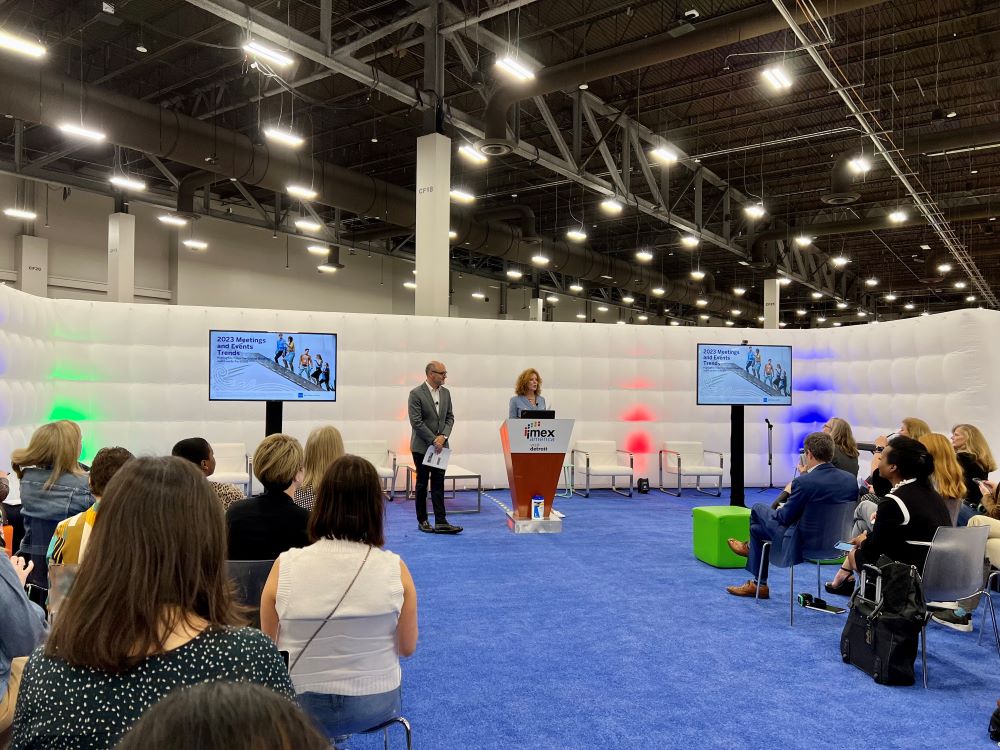Optimism and Growth: American Express Reveals 2023 Global Meetings & Events Forecast

American Express released its 2023 Global Meetings & Events Forecast at IMEX America this week, revealing a positive outlook for the recovery of in-person meetings and events, and a steady focus on initiatives surrounding sustainability and diversity, equity and inclusion (DEI).
“I think the biggest change this year, which is a positive one for the industry, is about optimism and growth,” said Gerardo Tejado, general manager for American Express Meetings & Events. “There's a lot of optimism about the industry and the value we bring.”
More than 500 meeting planners from 23 countries were surveyed in May and June of this year for the forecast.
The annual report also shed light on some shifts in thinking from last year’s forecast, especially around the value of face-to-face meetings—internally and externally—for remote or hybrid employees and the evolving challenges already-busy meeting planners will continue to face as the industry recovers.
“A trend these past few years has been the hyper-charged meeting planners. The role isn’t getting any easier,” noted Linda McNairy, VP of the Americas for American Express Meetings & Events. “It’s not just COVID protocols. There are also geopolitical issues that are impacting where you’re having your meeting or event.
Some key insights from the report include:
- 77% of respondents are likely to be optimistic (rating eight or above out of 10) about the health of the industry headed into 2023. That is a 6% increase compared to last year’s report.
- Nearly two thirds (67%) of respondents are likely to expect in-person attendee numbers to revert back to pre-pandemic levels within 1-2 years.
- 65% of respondents anticipate meetings and events spending to increase in 2023.
- In-person meetings, as well as the number of attendees at those meetings, will increase across the board, with 87% of meetings expected to have an in-person component.
- Sustainability continues to be a priority for meeting and event programs in 2023: Four in five respondents (80%) indicated their organization takes sustainability into account when planning meetings and events. Of those that responded their organization takes sustainability into account, 76% said that their organization has a defined sustainable meeting program strategy.
- Incorporating diversity, equity and inclusion (DEI) into meetings and events was also a top priority for meeting professionals. Nearly nine in 10 (87%) respondents said their organization or client actively strives to incorporate DEI in 2023.
“The three biggest growth drivers for meetings were internal meetings, product launches—because you still have to do business on that front—and incentives,” Tejado added. “And I think incentives also plays off the internal piece, because what you want to make sure is that you almost pamper some of your employees after everything that has happened [these past few years].”
Meetings Today Senior Content Director Danielle LeBreck sat down with Tejado at IMEX America 2022 in Las Vegas to discuss more about the forecasts’ findings, what responses surprised him the most and more. Listen to the full interview:
Read the full report and don’t miss additional IMEX America 2022 coverage. A full transcript of the interview is also available below.
Transcript
Danielle: Hello, and welcome to this Meetings Today Podcast. I'm Danielle LeBreck, senior content director with Meetings Today, and I'm on the IMEX America show floor in Las Vegas, sitting down with Gerardo Tejado, general manager at American Express Meetings & Events. Today, we are going to be diving in a little more to the 2023 Global Meetings & Events Forecast from American Express Meetings & Events.
Before we get started talking about some of the insights that came out of this forecast, for our listeners, can you just describe the methodology of this report? Who you surveyed, when you surveyed them?
Gerardo: Sure. So first, thanks for the time, Danielle. It's exciting to be here at IMEX. For this survey, it's the 12th year that we’ve done the forecast. And we surveyed over 500 professionals in more than 23 countries. And it was during the May-June timeframe, asking them what they thought 2023 would look like from a meeting perspective.
Danielle: Great. So, a lot has changed in the meetings and events were over these past few years. Looking back at last year's forecast compared to this year’s, were there any big shifts in thinking or changes that you noticed?
Gerardo: Sure, I think the biggest change, which is a positive one for the industry, it's about optimism and growth. I think if you look at the survey, almost 80% of participants gave, if you write from one to 10, what's the optimism in the industry, they rated it more than eight. So, there's a lot of optimism about the industry, the value we bring, but also about the challenges in managing through a new set of situations where there's probably labor shortages. There are also new requirements and new expectations about what a meeting can deliver on that front. But I think overall, people are very optimistic about the future. And you can see it with everything, with the participation here.
Danielle: Yeah, the show is really big this year, a lot of people are saying that it seems bigger than it was last year. So that optimism is definitely in the air. For you personally, was there anything in the forecast that really surprised you or stuck out?
Gerardo: The data was very consistent to what we're seeing internally. On that front, I would say the couple of things that stand out is how much the value of internal meetings is, and how they have become a key priority for companies. If you think about before the pandemic, internal meetings were always questioned. When you will need one, why you have to meet, why it's so expensive. But now as we have a more dispersed workforce, or virtual workforce, or more than maybe only 50%, from the survey, people are back in the office full time, there is tremendous value of having internal meetings, not only to bring back people to get together, but to build a sense of culture.
At the end of the day, for a lot of our clients, the workforce that they had pre-pandemic, and what they have now is completely different. There's been a lot of turnover, obviously. And a lot of industries kind of had a lot of growth. So, you need to make sure that your employees know how your company works. If you're not in the office, you have to meet face to face. So, I think that is very important.
The other piece that came out, the three biggest growth drivers for meetings, were internal meetings, product launches—because you still have to do business on that front—and incentives. And I think incentives also plays off the internal piece, because what you want to make sure is that you almost pamper some of your employees after everything that has happened. So, incentives. It's also a big part of what we've seen going forward.
Danielle: That’s really interesting. And the flip side of that, we've talked about a lot of optimism. What does this report reveal to be some of the biggest challenges for the meetings and events industry going into this next year?
Gerardo: Well, I think one of the biggest challenges is, if you think about it, it's becoming a supplier market, and costs are going up. So that is a big challenge—making sure that when you speak with your stakeholders in your companies, that you understand that at this point in time, if you want to do something similar, either you need to adapt and change the format or you probably will have to increase budgets to make things up, and I think that is one challenge.
I think the other one is the value of the meeting planner, because you really need to make sure that a meeting planner now—it's not just about getting things done, right? But it's making sure you have the right attendee experience. You're worried about duty of care, you make sure you work on technology, which now has become more of a backup more than anything. On the survey, we found that there was a six-percentage point increase in the number of meetings that will have an in-person component. So, I think it's becoming more holistic. And what that means is that companies need to adapt. And I think the good thing for our industry is that meetings are becoming a more relevant topic with senior managers, right, and senior leaders from a company, because again, now you have to think about how to create the sense of culture again.
Danielle: Exactly. So, getting into some other themes that came out of the report, I understand that sustainability continues to really hold steady as a priority for survey respondents. Can you just expand a little bit more on this? How are meeting programs working to meet those sustainability goals?
Gerardo: Yeah, sustainability, I would say, and DEI, are the two things that came up as very critical into what's important. I do believe that sustainability is now on the top of mind of all of our senior leaders. I think that still, there's a small disconnect into what that means sharing from a meetings perspective, because there's so many things that you can influence. So, I think how to measure sustainability or becoming more sustainable in your meetings, it's still a pending action that we all need to address; we need to have a more consistent metrics on what to measure.
But the good thing is that there's so many things you can do, you can go from reduction of plastics, you can go to food waste, you can go to help local communities, you can go about obviously reducing CO2 usage. So, there's so many things to do. We just need to make sure their whole system ties up to the values of a company. What do you really want to accomplish at this point?
Danielle: Yeah. Also, DEI was a major focus of this survey—diversity, equity and inclusion. Can you explain a little bit more on what survey respondents had to say about this?
Gerardo: Yeah, sure. So, I think it also becomes very important that you make sure that you support both diverse participants, but also have diverse suppliers. So, I think it goes both ways. We have a special section actually on DEI and what you need to do to make sure that you have an event that is inclusive to all participants. And there's also a methodology into what you need to consider, because maybe sometimes you don't see some of the different items that you need to address from a diversity perspective. So, I think that's one thing that came up. And then from a supplier perspective is how can you make sure that you bring in more diverse suppliers across the entire end-to-end programs? I think both of those came in as becoming very important. More so in some, obviously, for certain reasons. I think that was very big in the U.S., to be frank, around how important DEI is, again, inclusivity for participants, but also around suppliers.
Danielle: Well, I know that the full forecast is being released today. And we're really looking forward to diving into that. That’s all the time we have. Thank you so much for sitting down and talking about these insights a little more, and everyone listening, stay tuned all week on MeetingsToday.com and on the Meetings Today Podcast for real-time updates from IMEX America.
Gerado: Thank you very much.
Read this next: International Incentive Travel Destination Comeback




